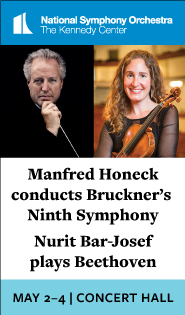Bates premiere fires a dud but Noseda leads NSO in a thundering Mahler First

Gianandrea Noseda conducted the National Symphony Orchestra in music of Mahler and Mason Bates Thursday night at the Kennedy Center.
So few living composers get the chance to have a full-length work for large orchestra commissioned and performed. In his position as composer-in-residence at the Kennedy Center the last few years, Mason Bates has seen the National Symphony Orchestra perform a whole series of his works.
The latest came on Thursday night, when Gianandrea Noseda conducted the world premiere of a new work by Bates, alongside Mahler’s Symphony No. 1.
How disappointing that in Art of War, a half-hour symphonic work paid for by the NSO’s John and June Hechinger Commissioning Fund, Bates covered no new ground in terms of process or overall effect. The work’s three movements had much in common with other recent Bates pieces played by the NSO, like Garages of the Valley, Passage, and Liquid Interface. Much of the orchestral texture consisted of atmospheric, Doppler-effect crescendos and repeated syncopations, into which Bates wove electronic beats and recorded sound snippets.
In the first movement, “Money as a weapons system,” the words of a tour guide place the origin of the recorded sound as the Bureau of Printing and Engraving here in Washington. As the money printing machines whir to life, syncopated patterns enlivened the more static chords of the opening, with an energy like the score for a 1970s bank caper. The slow middle movement, “Two Worlds,” achieved the greatest variety, morphing seamlessly from American country music or jazz into Middle Eastern folk music and back again.
The pacing slowly cranked up again during the transition to the finale, “On the March,” signaled by the actual marching sounds created by the orchestra’s feet. All in all, war here sounded heady and fun, with the percussion section cued up like a college marching band drumline, complete with shouted chants (“Semper Fi”). Here the sampled sounds featured a mortar team exploding ordinance, with some deep bass rumbles over the speakers. A brief closing section evoking American and Middle Eastern mourning services wrapped up the piece with a bow.
Bates’s new work was not unpleasant to hear, but the score strung random ideas together in a rather unconvincing whole. Anodyne and filled with jaunty rhythms, it could have accompanied a military recruitment video. The Kennedy Center announced last year that it was extending the term of Mason Bates as composer-in-residence through the end of the 2019-2020 season. Two years remain for him to produce something more substantial.
Fortunately the First Symphony, once known as “Titan,” came to the rescue on the second half. After years of overwrought Mahler from Christoph Eschenbach, Noseda took an approach balanced between high drama and continental suavity. The first movement opened in a space of ethereal calm, dotted with insect buzzes and bird calls from the woodwinds. Hunting horns and distant military clarions added to the air of anticipation. The offstage trumpets featured a few rough attacks, but in general the brass were solid.
Noseda went for more raucous and earthy sounds in the second movement, with the low strings digging into their attacks. The change of tone announced by the horn led to the more lyrical middle section, featuring wonderfully boozy string portamenti, a glimpse of the refined inner parlor from the beer garden.
The opening double-bass solo of the third movement was a beautiful comic-solemn moment in the hands of principal Robert Oppelt,. This was by far the most successful movement, with the folk music outbursts and frothy string serenades woven convincingly into the fabric rather than standing out starkly. The finale played out largely like a shout to the heavens, with emphasis on speed and ear-shattering volume from Noseda.
The orchestra responded with fervor and fire, from the thundering double timpani to the choir of seven horns that stood up for the closing chorale section. True to Mahler’s instruction, the group was augmented by “an extra trumpet and an extra trombone,” which only added to the thrill.
The program will be repeated 8 p.m. Saturday and 3 p.m. Sunday. kennedy-center.org; 202-467-4600


